Marketing Strategies Report: HTC Vive VR in the Australian Market
VerifiedAdded on 2020/03/23
|8
|4116
|30
Report
AI Summary
This marketing management report analyzes customer behavior and proposes strategies to influence customer preferences towards the HTC Vive VR in the Australian market. It compares HTC Vive VR with Samsung Gear VR, both categorized as entertainment products meeting esteem needs. The report examines customer decision-making processes, including pricing, risk, quality, and involvement levels. It details the value proposition and marketing mix of both products, focusing on the target customer segment. The analysis includes an overview of the nominated product (Samsung Gear VR) and the competing product (HTC Vive VR), their value propositions, and marketing mixes. The report identifies goals and objectives for HTC Vive VR, proposing strategies for its value proposition and marketing mix to gain a stronger market presence. It justifies the selected strategies and concludes with recommendations. Key aspects include theoretical approaches to customer behavior, risk assessment, quality considerations, and the importance of short-term goals and stakeholder involvement. The report emphasizes the significance of customer opinions and experiences in promotion, suggesting areas where HTC Vive VR can improve its marketing efforts compared to Samsung Gear VR.

Running head: REPORT
Changing Brand Preference
Name of the Student
Name of the University
Author’s Note
Changing Brand Preference
Name of the Student
Name of the University
Author’s Note
Paraphrase This Document
Need a fresh take? Get an instant paraphrase of this document with our AI Paraphraser
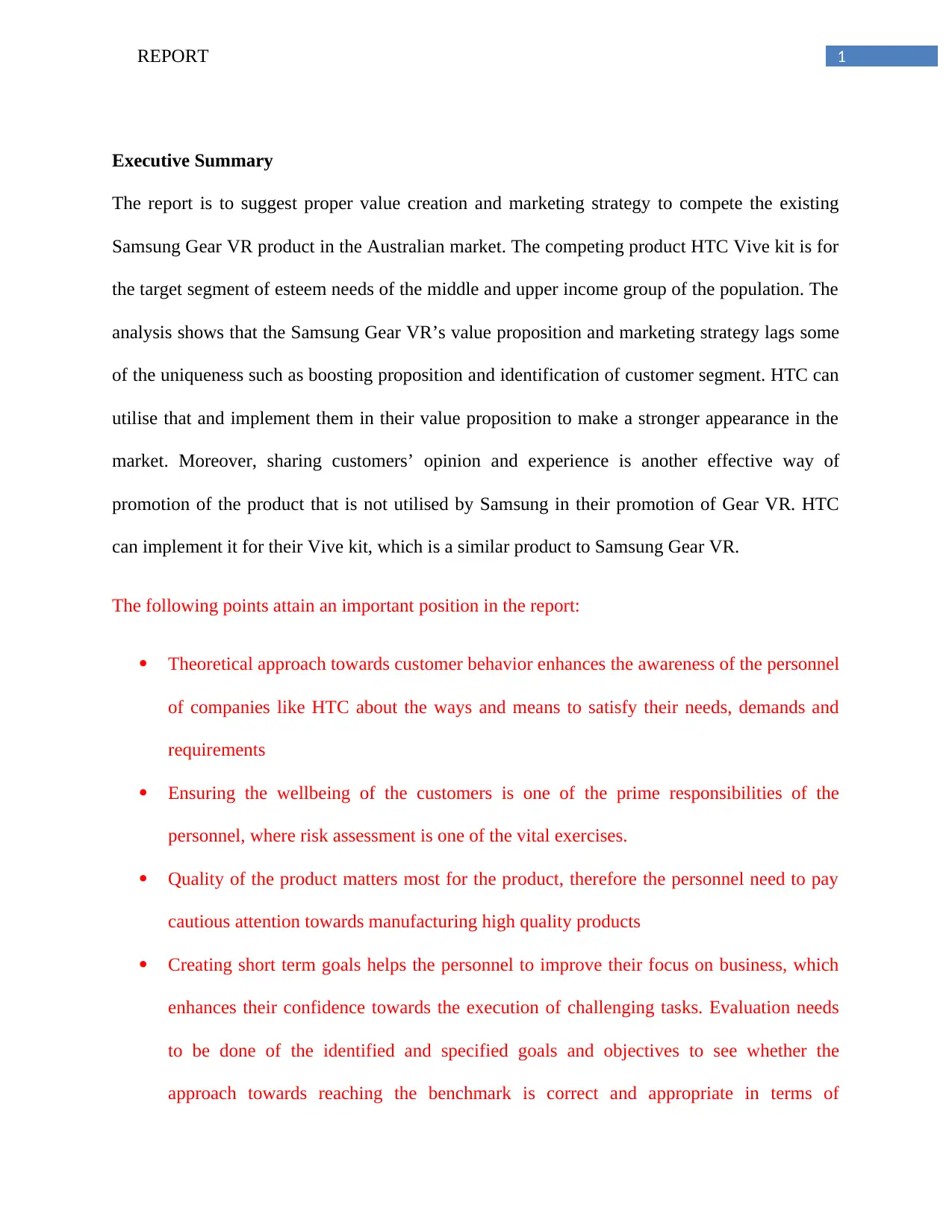
1REPORT
Executive Summary
The report is to suggest proper value creation and marketing strategy to compete the existing
Samsung Gear VR product in the Australian market. The competing product HTC Vive kit is for
the target segment of esteem needs of the middle and upper income group of the population. The
analysis shows that the Samsung Gear VR’s value proposition and marketing strategy lags some
of the uniqueness such as boosting proposition and identification of customer segment. HTC can
utilise that and implement them in their value proposition to make a stronger appearance in the
market. Moreover, sharing customers’ opinion and experience is another effective way of
promotion of the product that is not utilised by Samsung in their promotion of Gear VR. HTC
can implement it for their Vive kit, which is a similar product to Samsung Gear VR.
The following points attain an important position in the report:
Theoretical approach towards customer behavior enhances the awareness of the personnel
of companies like HTC about the ways and means to satisfy their needs, demands and
requirements
Ensuring the wellbeing of the customers is one of the prime responsibilities of the
personnel, where risk assessment is one of the vital exercises.
Quality of the product matters most for the product, therefore the personnel need to pay
cautious attention towards manufacturing high quality products
Creating short term goals helps the personnel to improve their focus on business, which
enhances their confidence towards the execution of challenging tasks. Evaluation needs
to be done of the identified and specified goals and objectives to see whether the
approach towards reaching the benchmark is correct and appropriate in terms of
Executive Summary
The report is to suggest proper value creation and marketing strategy to compete the existing
Samsung Gear VR product in the Australian market. The competing product HTC Vive kit is for
the target segment of esteem needs of the middle and upper income group of the population. The
analysis shows that the Samsung Gear VR’s value proposition and marketing strategy lags some
of the uniqueness such as boosting proposition and identification of customer segment. HTC can
utilise that and implement them in their value proposition to make a stronger appearance in the
market. Moreover, sharing customers’ opinion and experience is another effective way of
promotion of the product that is not utilised by Samsung in their promotion of Gear VR. HTC
can implement it for their Vive kit, which is a similar product to Samsung Gear VR.
The following points attain an important position in the report:
Theoretical approach towards customer behavior enhances the awareness of the personnel
of companies like HTC about the ways and means to satisfy their needs, demands and
requirements
Ensuring the wellbeing of the customers is one of the prime responsibilities of the
personnel, where risk assessment is one of the vital exercises.
Quality of the product matters most for the product, therefore the personnel need to pay
cautious attention towards manufacturing high quality products
Creating short term goals helps the personnel to improve their focus on business, which
enhances their confidence towards the execution of challenging tasks. Evaluation needs
to be done of the identified and specified goals and objectives to see whether the
approach towards reaching the benchmark is correct and appropriate in terms of
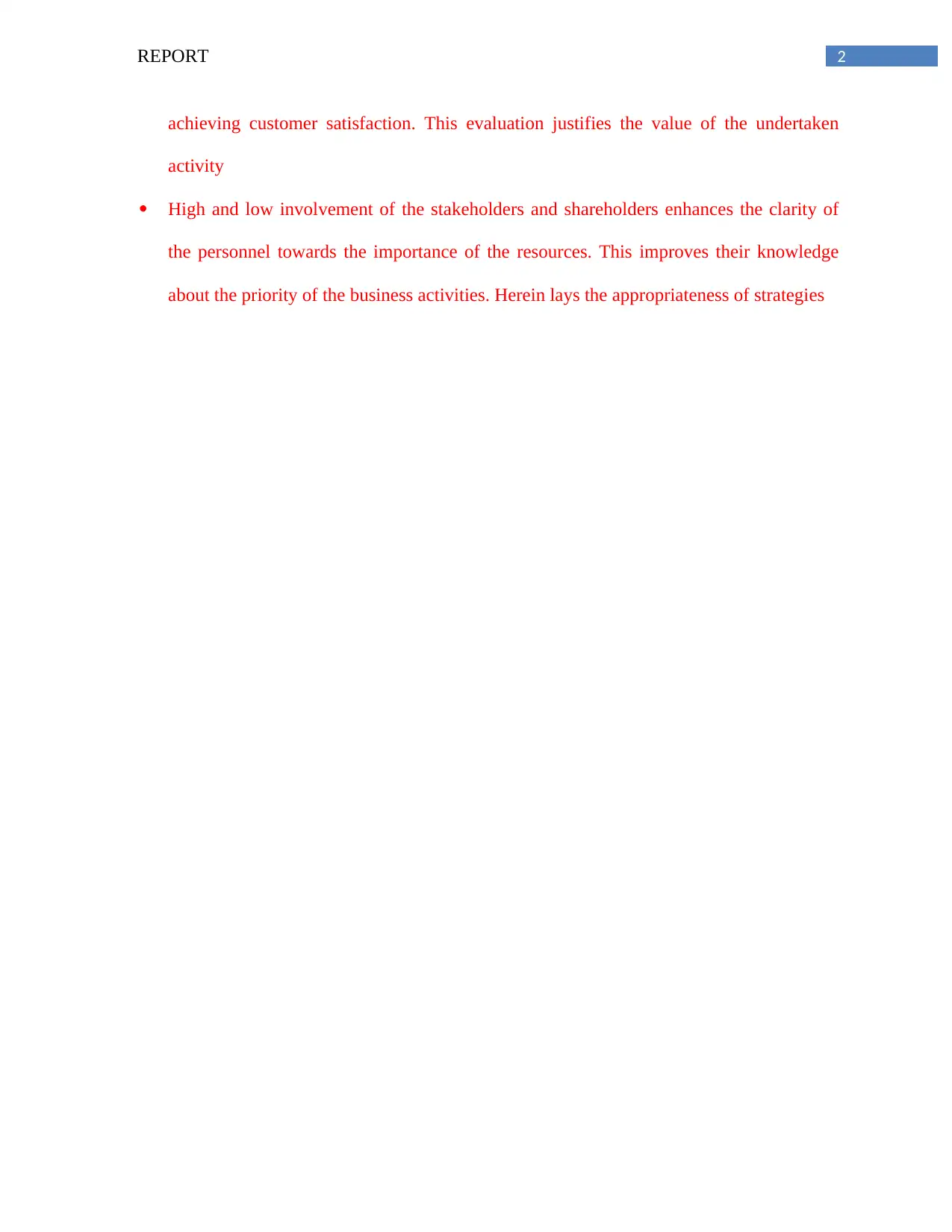
2REPORT
achieving customer satisfaction. This evaluation justifies the value of the undertaken
activity
High and low involvement of the stakeholders and shareholders enhances the clarity of
the personnel towards the importance of the resources. This improves their knowledge
about the priority of the business activities. Herein lays the appropriateness of strategies
achieving customer satisfaction. This evaluation justifies the value of the undertaken
activity
High and low involvement of the stakeholders and shareholders enhances the clarity of
the personnel towards the importance of the resources. This improves their knowledge
about the priority of the business activities. Herein lays the appropriateness of strategies
⊘ This is a preview!⊘
Do you want full access?
Subscribe today to unlock all pages.

Trusted by 1+ million students worldwide
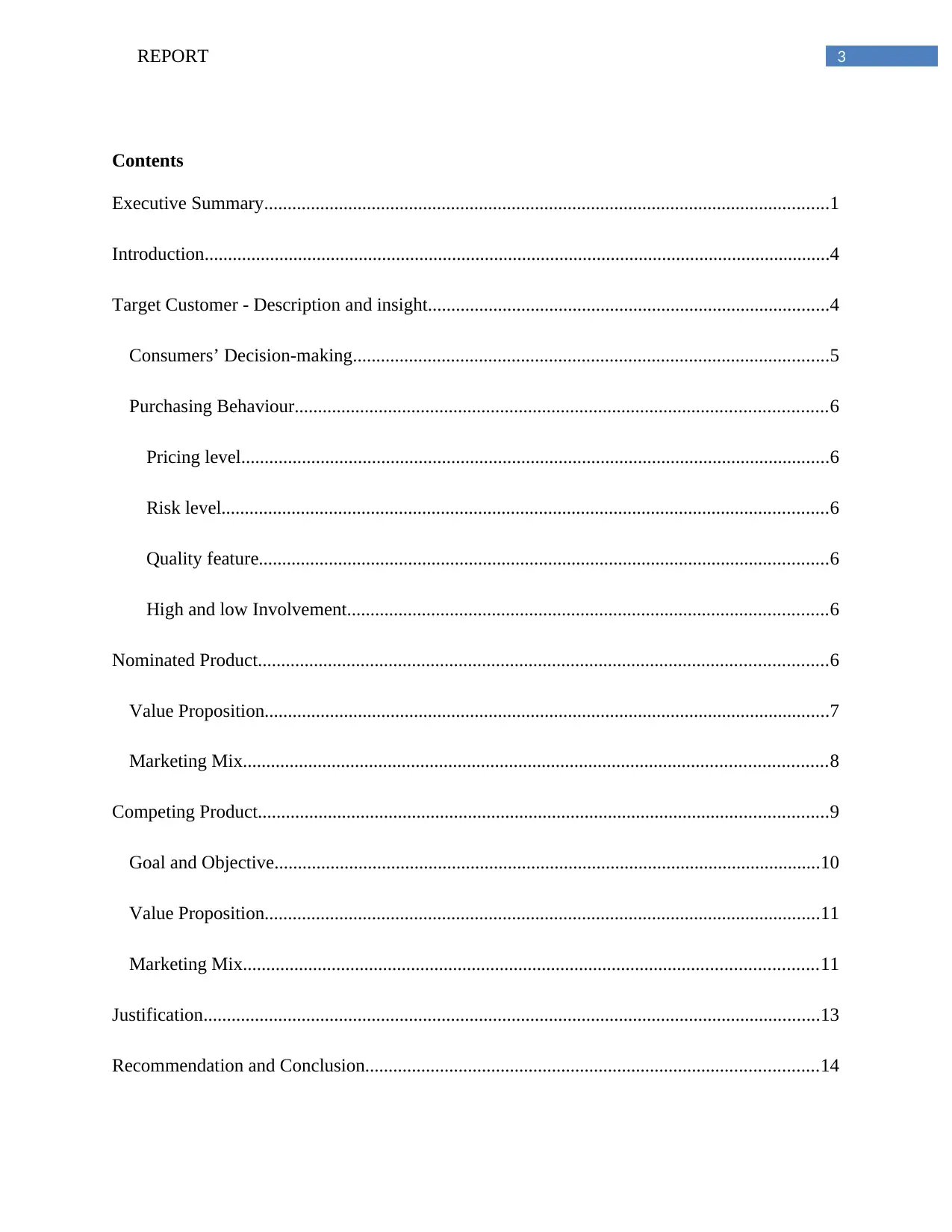
3REPORT
Contents
Executive Summary.........................................................................................................................1
Introduction......................................................................................................................................4
Target Customer - Description and insight......................................................................................4
Consumers’ Decision-making......................................................................................................5
Purchasing Behaviour..................................................................................................................6
Pricing level..............................................................................................................................6
Risk level..................................................................................................................................6
Quality feature..........................................................................................................................6
High and low Involvement.......................................................................................................6
Nominated Product..........................................................................................................................6
Value Proposition.........................................................................................................................7
Marketing Mix.............................................................................................................................8
Competing Product..........................................................................................................................9
Goal and Objective.....................................................................................................................10
Value Proposition.......................................................................................................................11
Marketing Mix...........................................................................................................................11
Justification....................................................................................................................................13
Recommendation and Conclusion.................................................................................................14
Contents
Executive Summary.........................................................................................................................1
Introduction......................................................................................................................................4
Target Customer - Description and insight......................................................................................4
Consumers’ Decision-making......................................................................................................5
Purchasing Behaviour..................................................................................................................6
Pricing level..............................................................................................................................6
Risk level..................................................................................................................................6
Quality feature..........................................................................................................................6
High and low Involvement.......................................................................................................6
Nominated Product..........................................................................................................................6
Value Proposition.........................................................................................................................7
Marketing Mix.............................................................................................................................8
Competing Product..........................................................................................................................9
Goal and Objective.....................................................................................................................10
Value Proposition.......................................................................................................................11
Marketing Mix...........................................................................................................................11
Justification....................................................................................................................................13
Recommendation and Conclusion.................................................................................................14
Paraphrase This Document
Need a fresh take? Get an instant paraphrase of this document with our AI Paraphraser
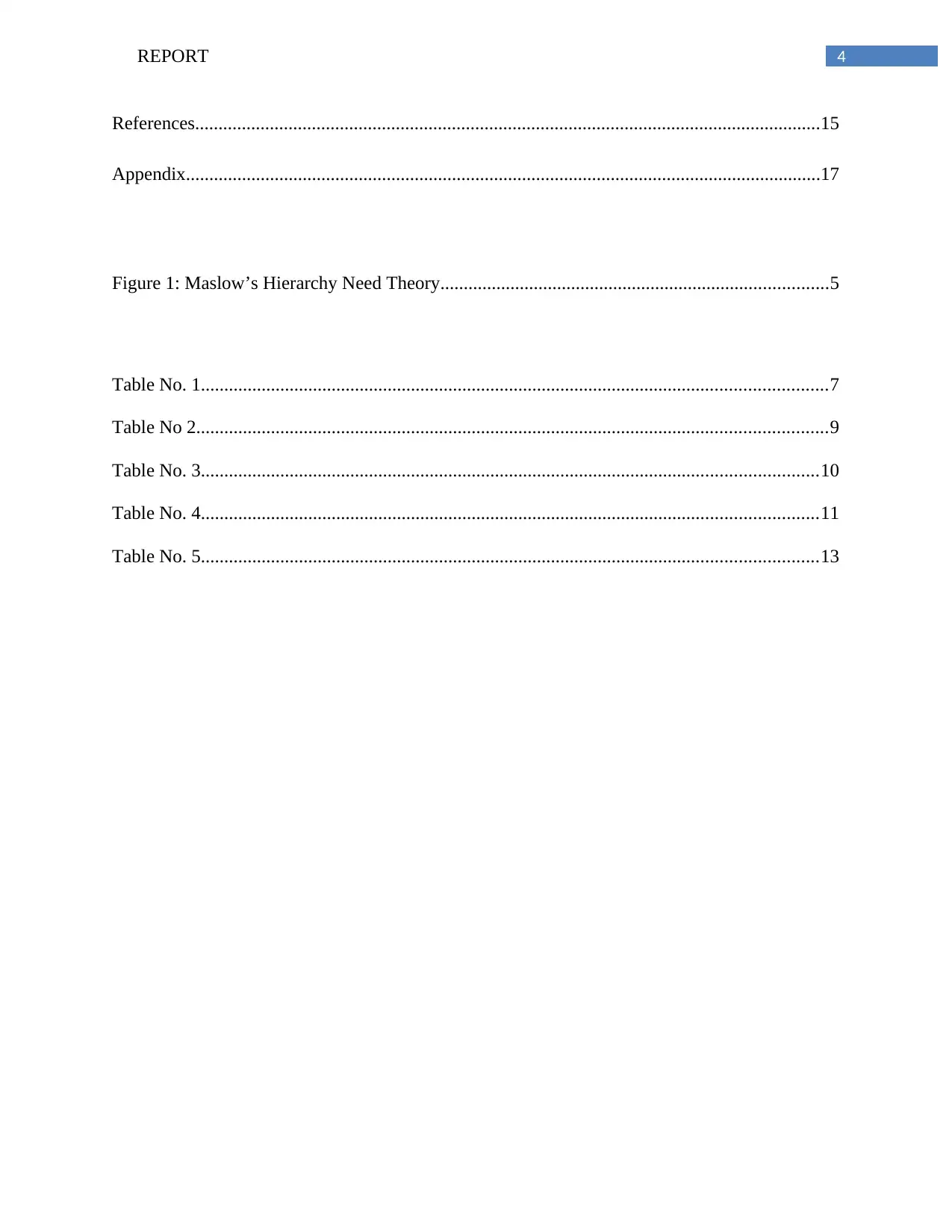
4REPORT
References......................................................................................................................................15
Appendix........................................................................................................................................17
Figure 1: Maslow’s Hierarchy Need Theory...................................................................................5
Table No. 1......................................................................................................................................7
Table No 2.......................................................................................................................................9
Table No. 3....................................................................................................................................10
Table No. 4....................................................................................................................................11
Table No. 5....................................................................................................................................13
References......................................................................................................................................15
Appendix........................................................................................................................................17
Figure 1: Maslow’s Hierarchy Need Theory...................................................................................5
Table No. 1......................................................................................................................................7
Table No 2.......................................................................................................................................9
Table No. 3....................................................................................................................................10
Table No. 4....................................................................................................................................11
Table No. 5....................................................................................................................................13
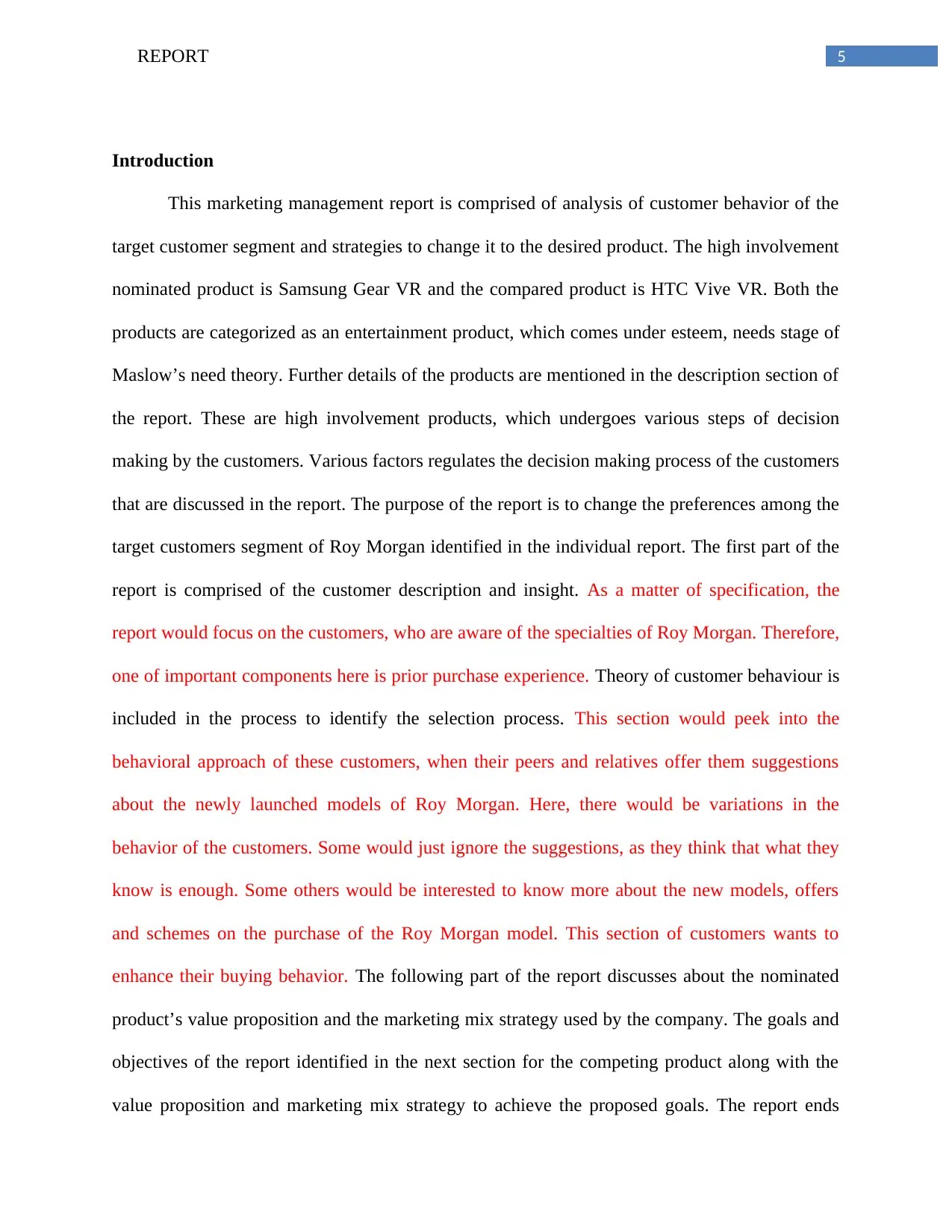
5REPORT
Introduction
This marketing management report is comprised of analysis of customer behavior of the
target customer segment and strategies to change it to the desired product. The high involvement
nominated product is Samsung Gear VR and the compared product is HTC Vive VR. Both the
products are categorized as an entertainment product, which comes under esteem, needs stage of
Maslow’s need theory. Further details of the products are mentioned in the description section of
the report. These are high involvement products, which undergoes various steps of decision
making by the customers. Various factors regulates the decision making process of the customers
that are discussed in the report. The purpose of the report is to change the preferences among the
target customers segment of Roy Morgan identified in the individual report. The first part of the
report is comprised of the customer description and insight. As a matter of specification, the
report would focus on the customers, who are aware of the specialties of Roy Morgan. Therefore,
one of important components here is prior purchase experience. Theory of customer behaviour is
included in the process to identify the selection process. This section would peek into the
behavioral approach of these customers, when their peers and relatives offer them suggestions
about the newly launched models of Roy Morgan. Here, there would be variations in the
behavior of the customers. Some would just ignore the suggestions, as they think that what they
know is enough. Some others would be interested to know more about the new models, offers
and schemes on the purchase of the Roy Morgan model. This section of customers wants to
enhance their buying behavior. The following part of the report discusses about the nominated
product’s value proposition and the marketing mix strategy used by the company. The goals and
objectives of the report identified in the next section for the competing product along with the
value proposition and marketing mix strategy to achieve the proposed goals. The report ends
Introduction
This marketing management report is comprised of analysis of customer behavior of the
target customer segment and strategies to change it to the desired product. The high involvement
nominated product is Samsung Gear VR and the compared product is HTC Vive VR. Both the
products are categorized as an entertainment product, which comes under esteem, needs stage of
Maslow’s need theory. Further details of the products are mentioned in the description section of
the report. These are high involvement products, which undergoes various steps of decision
making by the customers. Various factors regulates the decision making process of the customers
that are discussed in the report. The purpose of the report is to change the preferences among the
target customers segment of Roy Morgan identified in the individual report. The first part of the
report is comprised of the customer description and insight. As a matter of specification, the
report would focus on the customers, who are aware of the specialties of Roy Morgan. Therefore,
one of important components here is prior purchase experience. Theory of customer behaviour is
included in the process to identify the selection process. This section would peek into the
behavioral approach of these customers, when their peers and relatives offer them suggestions
about the newly launched models of Roy Morgan. Here, there would be variations in the
behavior of the customers. Some would just ignore the suggestions, as they think that what they
know is enough. Some others would be interested to know more about the new models, offers
and schemes on the purchase of the Roy Morgan model. This section of customers wants to
enhance their buying behavior. The following part of the report discusses about the nominated
product’s value proposition and the marketing mix strategy used by the company. The goals and
objectives of the report identified in the next section for the competing product along with the
value proposition and marketing mix strategy to achieve the proposed goals. The report ends
⊘ This is a preview!⊘
Do you want full access?
Subscribe today to unlock all pages.

Trusted by 1+ million students worldwide
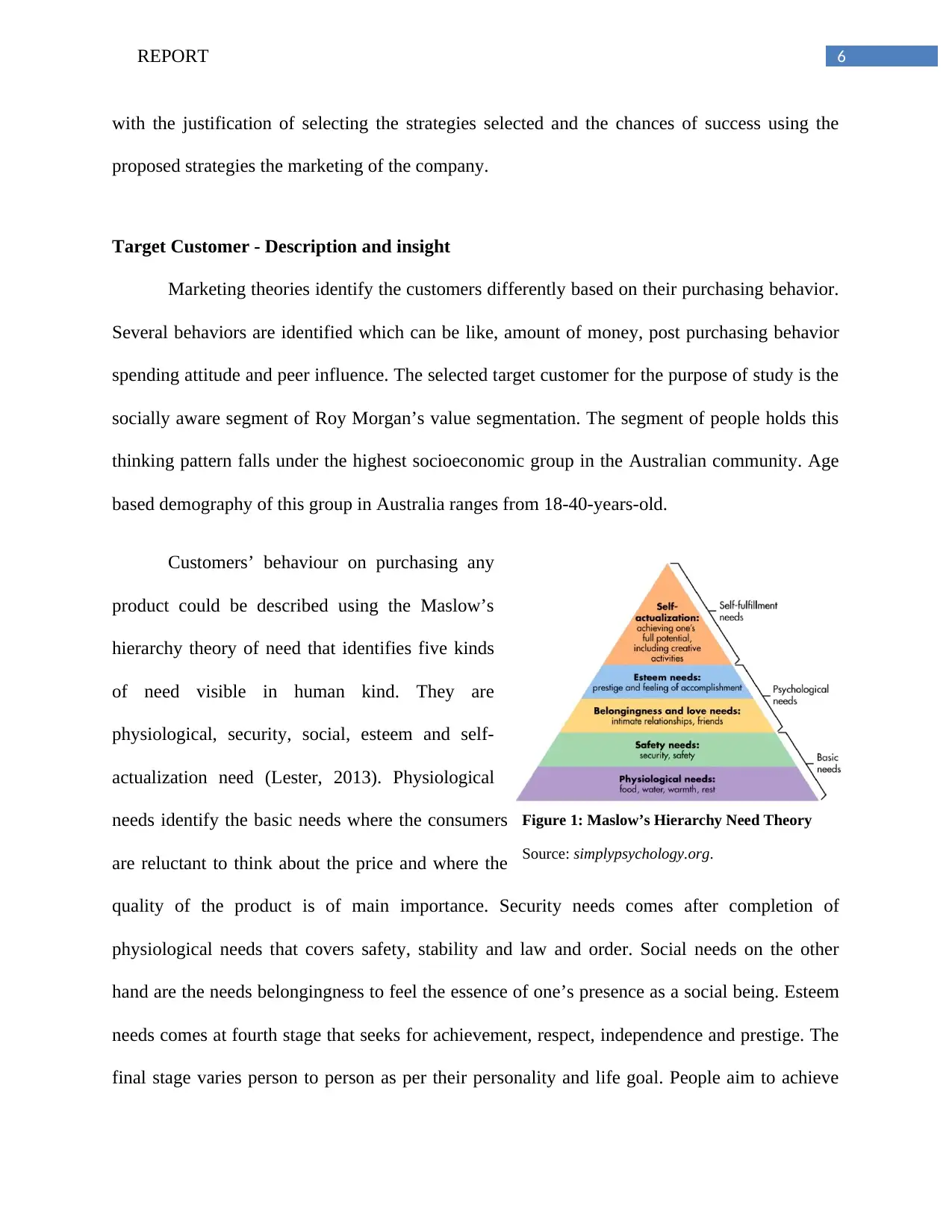
6REPORT
with the justification of selecting the strategies selected and the chances of success using the
proposed strategies the marketing of the company.
Target Customer - Description and insight
Marketing theories identify the customers differently based on their purchasing behavior.
Several behaviors are identified which can be like, amount of money, post purchasing behavior
spending attitude and peer influence. The selected target customer for the purpose of study is the
socially aware segment of Roy Morgan’s value segmentation. The segment of people holds this
thinking pattern falls under the highest socioeconomic group in the Australian community. Age
based demography of this group in Australia ranges from 18-40-years-old.
Customers’ behaviour on purchasing any
product could be described using the Maslow’s
hierarchy theory of need that identifies five kinds
of need visible in human kind. They are
physiological, security, social, esteem and self-
actualization need (Lester, 2013). Physiological
needs identify the basic needs where the consumers
are reluctant to think about the price and where the
quality of the product is of main importance. Security needs comes after completion of
physiological needs that covers safety, stability and law and order. Social needs on the other
hand are the needs belongingness to feel the essence of one’s presence as a social being. Esteem
needs comes at fourth stage that seeks for achievement, respect, independence and prestige. The
final stage varies person to person as per their personality and life goal. People aim to achieve
Figure 1: Maslow’s Hierarchy Need Theory
Source: simplypsychology.org.
with the justification of selecting the strategies selected and the chances of success using the
proposed strategies the marketing of the company.
Target Customer - Description and insight
Marketing theories identify the customers differently based on their purchasing behavior.
Several behaviors are identified which can be like, amount of money, post purchasing behavior
spending attitude and peer influence. The selected target customer for the purpose of study is the
socially aware segment of Roy Morgan’s value segmentation. The segment of people holds this
thinking pattern falls under the highest socioeconomic group in the Australian community. Age
based demography of this group in Australia ranges from 18-40-years-old.
Customers’ behaviour on purchasing any
product could be described using the Maslow’s
hierarchy theory of need that identifies five kinds
of need visible in human kind. They are
physiological, security, social, esteem and self-
actualization need (Lester, 2013). Physiological
needs identify the basic needs where the consumers
are reluctant to think about the price and where the
quality of the product is of main importance. Security needs comes after completion of
physiological needs that covers safety, stability and law and order. Social needs on the other
hand are the needs belongingness to feel the essence of one’s presence as a social being. Esteem
needs comes at fourth stage that seeks for achievement, respect, independence and prestige. The
final stage varies person to person as per their personality and life goal. People aim to achieve
Figure 1: Maslow’s Hierarchy Need Theory
Source: simplypsychology.org.
Paraphrase This Document
Need a fresh take? Get an instant paraphrase of this document with our AI Paraphraser
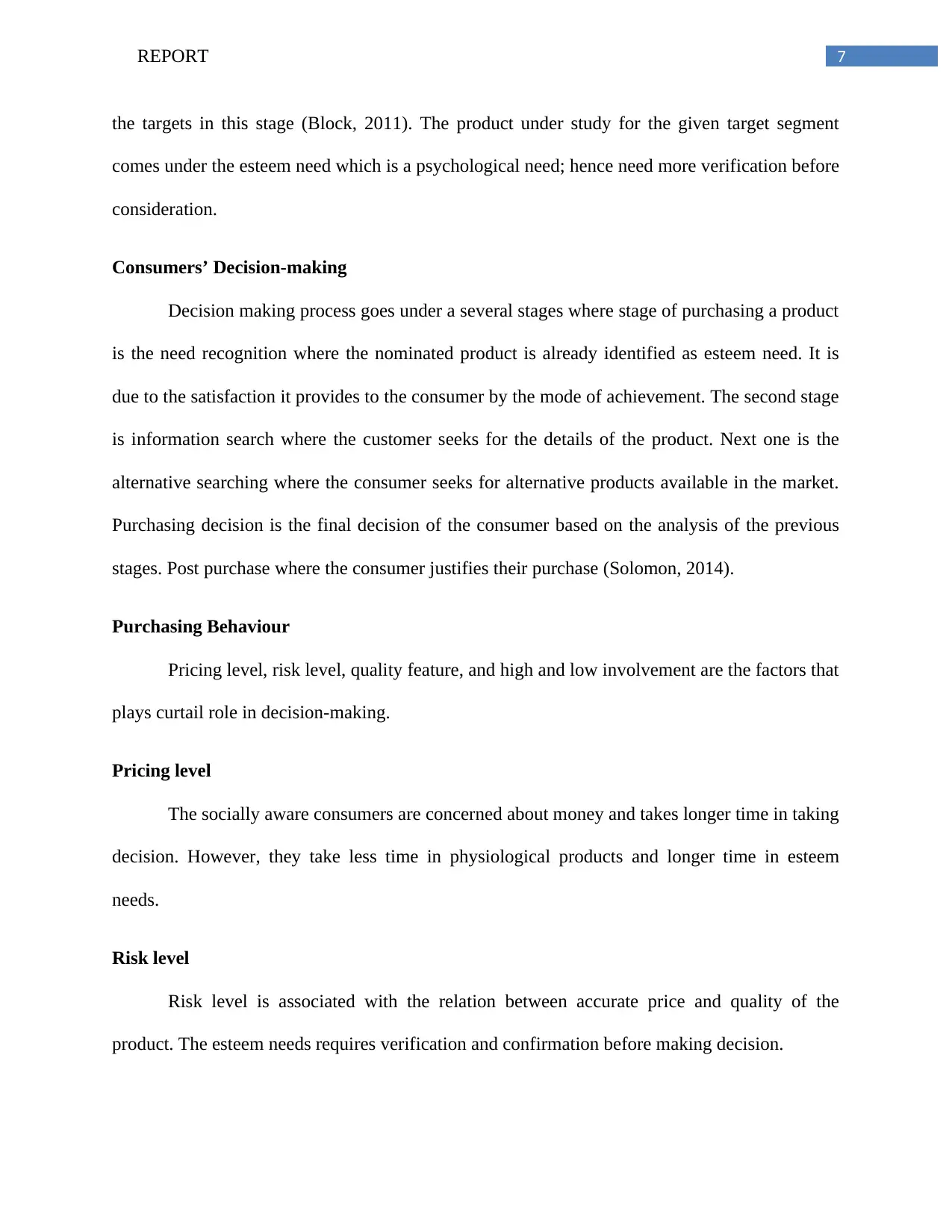
7REPORT
the targets in this stage (Block, 2011). The product under study for the given target segment
comes under the esteem need which is a psychological need; hence need more verification before
consideration.
Consumers’ Decision-making
Decision making process goes under a several stages where stage of purchasing a product
is the need recognition where the nominated product is already identified as esteem need. It is
due to the satisfaction it provides to the consumer by the mode of achievement. The second stage
is information search where the customer seeks for the details of the product. Next one is the
alternative searching where the consumer seeks for alternative products available in the market.
Purchasing decision is the final decision of the consumer based on the analysis of the previous
stages. Post purchase where the consumer justifies their purchase (Solomon, 2014).
Purchasing Behaviour
Pricing level, risk level, quality feature, and high and low involvement are the factors that
plays curtail role in decision-making.
Pricing level
The socially aware consumers are concerned about money and takes longer time in taking
decision. However, they take less time in physiological products and longer time in esteem
needs.
Risk level
Risk level is associated with the relation between accurate price and quality of the
product. The esteem needs requires verification and confirmation before making decision.
the targets in this stage (Block, 2011). The product under study for the given target segment
comes under the esteem need which is a psychological need; hence need more verification before
consideration.
Consumers’ Decision-making
Decision making process goes under a several stages where stage of purchasing a product
is the need recognition where the nominated product is already identified as esteem need. It is
due to the satisfaction it provides to the consumer by the mode of achievement. The second stage
is information search where the customer seeks for the details of the product. Next one is the
alternative searching where the consumer seeks for alternative products available in the market.
Purchasing decision is the final decision of the consumer based on the analysis of the previous
stages. Post purchase where the consumer justifies their purchase (Solomon, 2014).
Purchasing Behaviour
Pricing level, risk level, quality feature, and high and low involvement are the factors that
plays curtail role in decision-making.
Pricing level
The socially aware consumers are concerned about money and takes longer time in taking
decision. However, they take less time in physiological products and longer time in esteem
needs.
Risk level
Risk level is associated with the relation between accurate price and quality of the
product. The esteem needs requires verification and confirmation before making decision.
1 out of 8
Related Documents
Your All-in-One AI-Powered Toolkit for Academic Success.
+13062052269
info@desklib.com
Available 24*7 on WhatsApp / Email
![[object Object]](/_next/static/media/star-bottom.7253800d.svg)
Unlock your academic potential
Copyright © 2020–2025 A2Z Services. All Rights Reserved. Developed and managed by ZUCOL.





